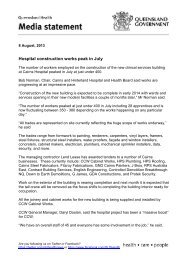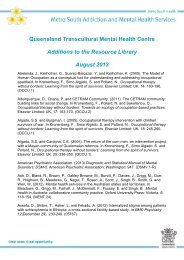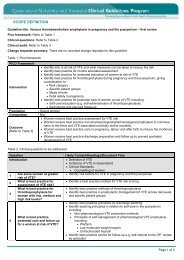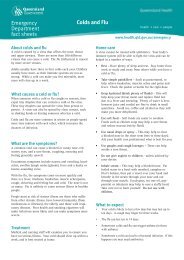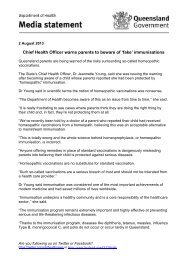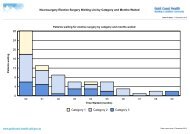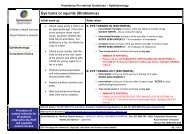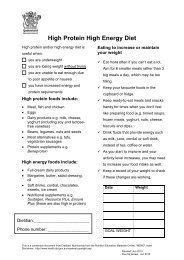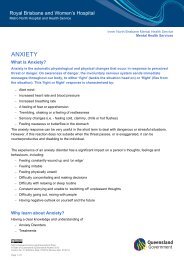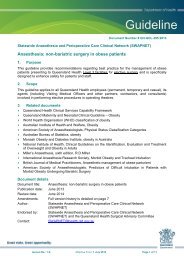Paediatrics - Queensland Health - Queensland Government
Paediatrics - Queensland Health - Queensland Government
Paediatrics - Queensland Health - Queensland Government
Create successful ePaper yourself
Turn your PDF publications into a flip-book with our unique Google optimized e-Paper software.
Paediatric presentation<br />
Physical examination - child (continued)<br />
Skin • Always check the whole body, particularly in a sick child<br />
• Rash ? non blanching, petechiae, purpura<br />
• Colour - unusually pale, mottled or cyanotic?<br />
• Bruising, unexplained or unusual marks?<br />
• Signs of infection: redness, swelling or tenderness?<br />
• Inspect / palpate lymph nodes in the neck, axillae or groins for tenderness<br />
• See Assessment and physical examination of skin, hair and nails for detailed<br />
assessment<br />
Growth • Height<br />
• Weight - if child < 2 years weigh naked<br />
• Head circumference if < 2 years<br />
• Plot on growth charts appropriate for age and gender<br />
Cardiovascular<br />
system<br />
Respiratory<br />
system<br />
Gastrointestinal<br />
and<br />
reproductive<br />
systems<br />
550<br />
• Skin colour - pink, white, grey mottling? Compare the trunk with the limbs<br />
• Skin temperature - hot, warm, cool, cold, sweating? Compare the trunk with the<br />
limbs<br />
• Palpate peripheral pulses - is rate fast, slow or normal - is the pulse volume weak<br />
or strong?<br />
• Central perfusion - blanch the skin over the sternum with your thumb for 5 seconds.<br />
Time how long it takes for the mark to disappear<br />
• Peripheral perfusion - ‘blanch’ the skin on a finger or toe for 5 seconds. Time how<br />
long it takes for the mark to disappear<br />
• Any evidence of oedema - particularly hands, feet and face?<br />
• If skilled, listen to heart sounds<br />
• Most information is gained through inspection<br />
• Inspect anterior / posterior chest:<br />
-- equal chest movement<br />
-- use of accessory muscles of respiration? Look for retraction, recession - mild,<br />
moderate or severe? Nasal flaring?<br />
• Can they talk continuously, or only in words or sentences, or unable to talk at all?<br />
• Measure respiratory rate over one minute, observe rhythm, depth and effort breathing<br />
• Listen for extra noises - cough, ± sputum, wheeze, stridor, grunt, snore, hoarse<br />
speech / cry<br />
• Auscultate air entry in both lung fields - equal? Adequate, decreased or absent? Are<br />
there wheezes or crackles? Do they occur on inspiration or expiration? (Note that<br />
transmitted sounds from the upper respiratory tract are very common in children and<br />
may mask other signs)<br />
• Will the child lie flat?<br />
• O saturation<br />
2<br />
• Look - are there any scars or abdominal distension / hernias<br />
• Auscultate bowel sounds - present or absent?<br />
• Palpate abdomen<br />
-- soft or firm?<br />
-- any obvious masses?<br />
-- tender to touch? Identify which abdominal quadrant and exact area<br />
-- any guarding / rigidity - even when the child is relaxed?<br />
-- any rebound tenderness - press down and take your hand away very quickly - is<br />
the pain greater when you do this?<br />
• Question about change in bowel habits<br />
• Feel for a palpable bladder<br />
• Check the testes in boys - are they both in the scrotum?<br />
-- any redness, swelling or tenderness?<br />
Controlled copy V1.0<br />
Primary Clinical Care Manual 2011



